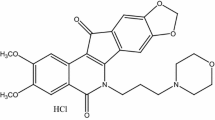Abstract
Purpose: Chloroethylnitrosoureas are among the most widely used chemotherapeutic agents for the treatment of brain tumors. SarCNU (1-(2-chloroethyl)-3-sarcosinamide-1-nitrosourea) is an investigational nitrosourea analogue that has shown greater antitumor activity and a more favorable toxicity profile than 1,3-bis(2-chloroethyl)-1-nitrosourea in preclinical studies. The purpose of the present study was to characterize the plasma pharmacokinetics and oral bioavailability of SarCNU in mice and dogs treated by intravenous infusion and gastric intubation. Methods: SarCNU was administered to mice by i.v. injection or orally at doses ranging from 10 to 100 mg/kg. Plasma samples were obtained from groups of five animals at each time-point at intervals ranging from 3 min to 2.5 h after dosing. A group of three male beagle dogs were treated with SarCNU 10 mg/kg given both by i.v. infusion and orally in a crossover design. The concentration of SarCNU in plasma was measured by high-performance liquid chromatography. Results: During the initial 90 min after i.v. injection to mice, SarCNU was eliminated from plasma in a monoexponential manner with a mean half-life of 9.8±0.8 min. The total plasma clearance was 47.3±8.7 ml/min per kg and the apparent volume of distribution was 0.7±0.1 l/kg. SarCNU exhibited linear pharmacokinetic behavior following both i.v. and oral administration of doses ranging from approximately 10 to 100 mg/kg. Peak plasma levels provided by a dose of 100 mg/kg given by the i.v. and oral routes were 142.4 µg/ml (0.5 min) and 27.8 µg/ml (9.8 min), respectively. The mean oral bioavailability of the drug was 57.3±12.6% in mice. In comparison, the disposition of SarCNU in dogs after rapid i.v. injection was biexponential, with half-lives of 5.4±8.4 min and 40.8±9.0 min for the initial and terminal disposition phases, respectively. Mean values of the total plasma clearance and apparent volume of distribution were 17.8±1.8 ml/min per kg and 1.1±0.3 l/kg, respectively. The Cmax was 18.5±6.5 µg/ml after i.v. injection and 8.5±0.4 µg/ml after oral administration of a 10 mg/kg dose. Oral bioavailability of the drug in dogs (71.7±21.2%) was greater than that observed in mice. Conclusions: SarCNU exhibited linear and consistent pharmacokinetics in mice and dogs with very good oral bioavailability in both species. These findings support the rationale for evaluating SarCNU given by the oral route of administration in phase I clinical trials.
Similar content being viewed by others
Author information
Authors and Affiliations
Additional information
Electronic Publication
Rights and permissions
About this article
Cite this article
Supko, J.G., Garcia-Carbonero, R., Puchalski, T.A. et al. Plasma pharmacokinetics and bioavailability of 1-(2-chloroethyl)-3-sarcosinamide-1-nitrosourea after intravenous and oral administration to mice and dogs. Cancer Chemother Pharmacol 48, 202–208 (2001). https://doi.org/10.1007/s002800100326
Received:
Accepted:
Issue Date:
DOI: https://doi.org/10.1007/s002800100326




